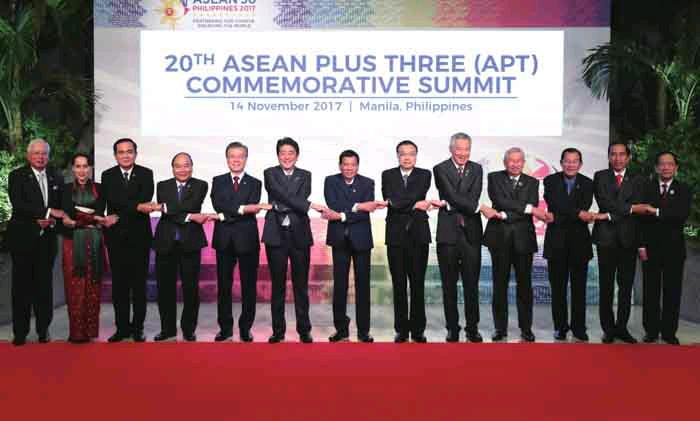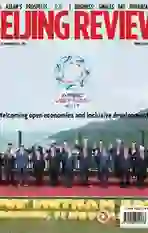Wide Vision
2017-12-01ByWenQing
By+Wen+Qing
Chinas relationship with the Association of Southeast Asian Nations (ASEAN) is the most vibrant of all the associations ties with its other dialogue partners. That is the consensus of ASEAN and was espoused by Chinese Premier Li Keqiang when he addressed the 20th China-ASEAN (10+1) leaders meeting on November 13.
The meeting also marked the golden jubilee of ASEAN, a regional bloc that promotes political, economic and security collaboration among its 10 members: Brunei, Cambodia, Indonesia, Laos, Malaysia, Myanmar, the Philippines, Singapore, Thailand and Viet Nam.
As the first major country outside the bloc to endorse the Treaty of Amity and Cooperation in Southeast Asia and to establish a strategic partnership with ASEAN, China has hailed the progress of countries in Southeast Asia in the past decades. Since the establishment of ASEAN in 1967, the situation in Southeast Asia has gone from a poverty-stricken, conflict-riddled region to one with the greatest growth potential in the world.
Alongside the regions impressive progress in economic and social development, ASEAN, the central organization in regional cooperation, strives to play a bigger role to improve regional security and enhance regional integration by joining hands with China. This was evident at the 31st ASEAN Summit from November 13-14, and related meetings held in the Philippine capital of Manila.
Regional security
The South China Sea seems to be the preeminent issue on peoples lips when it comes to China-ASEAN cooperation. Even before this summit, there was media speculation that this contentious issue would dominate proceedings and be the proverbial elephant in the room.
However, President Rodrigo Duterte of the Philippines focused on the fight against terrorism, the illegal drug trade and other issues at the opening of the summit, and made no mention of the disputes. That was in line with his attitude at the previous ASEAN Summit, at which he refused to talk about the so-called “South China Sea arbitration.”
Duterte met with Chinese President Xi Jinping on the sidelines of the Asia-Pacific Economic Cooperation (APEC) Economic Leaders Meeting in Da Nang, Viet Nam. “He[Xi] made it clear to us that the only way to go [forward] is cooperation. And so we should open our doors to everybody. Ideological conflicts are no longer in vogue, its passé,”said Duterte.
Cooperation is also the only option for a peaceful and prosperous South China Sea from Chinas point of view. At the 20th ChinaASEAN (10+1) leaders meeting, Premier Li Keqiang announced that China and ASEAN would start consultations on the wording of the Code of Conduct (COC) in the South China Sea. After the framework of the COC was endorsed at the China-ASEAN Foreign Ministers Meeting in August, the start of the written agreement was a step forward toward a long-term peaceful solution.endprint
Philippine Presidential Spokesperson Harry Roque echoed Lis proposals. “One of the outcomes of the meetings is to commence negotiations on a substantive and effective Code of Conduct in the South China Sea after concluding the Framework Agreement on the Code of Conduct,” Roque said in a statement.
COC was envisioned to be a rule-based framework, including a set of norms to guide the behavior of related parties and to promote maritime cooperation in the South China Sea, according to Wilfrido Villacorta, former Philippine Ambassador and permanent representative to ASEAN. If the COC is fully implemented and all related parties comply with its provisions in the future, there will likely be no major risks or crisis in this region, he told Xinhua News Agency in an interview.
Ge Hongliang, a researcher at The Chahar Institute, said the COC could remove the neighboring countries suspicion of Chinas normal activities in the South China Sea.
“Through consultations on the COC, we hope that all parties can enhance their mutual understanding and trust, and strive to adopt the COC at an early date on the basis of consensus and make it a stabilizer of peace in the South China Sea,” Premier Li said in the meeting.
However, the written agreement, as the most vital part of the whole process of the COC, will touch several sensitive and complex issues and be unavoidably confronted with many challenges.
“During the negotiation, China and ASEAN countries need to prevent intervention from non-regional forces. China needs to make its presence in the region benefit other countries and not let the disputes interrupt pragmatic cooperation with ASEAN. This way, non-regional powers like the U.S. and Japan will have less chance to intervene,” said Xu Liping, a senior research fellow with the National Institute of International Strategy at the Chinese Academy of Social Sciences.
Promoting integration
With “Partnering for Change, Engaging the World” as the theme of the 31st ASEAN Summit, the bloc explicitly expressed the will to work with its partners to further regional economic integration against the backdrop of antiglobalization. Such development, characterized by openness, conforms to the China-proposed Belt and Road Initiative.
To strengthen bilateral cooperation, Li proposed the formulation of a vision for the strategic partnership between China and ASEAN toward the year 2030 at this ChinaASEAN leaders meeting, which will upgrade the China-ASEAN cooperation framework from two plus seven (2+7) to three plus X(3+X).endprint
The current 2+7 framework refers to a two-point political consensus of enhancing strategic trust and promoting economic cooperation, and seven cooperation fields including trade facilitation, interconnectivity and security exchanges. But the newlyproposed 3+X framework, using the letter X to indicate an unknown quantity, stresses that China-ASEAN will seek cooperation in more fields based on three pillars—political security, economy and trade, and people-topeople exchanges.
Another highlight is the first leadersmeeting of the Regional Comprehensive Economic Partnership (RCEP) since it was launched. After it was initiated at the ASEAN Summit in Cambodia in 2012, 20 rounds of negotiations and eight ministerial meetings have been held. And the leaders meeting during this summit is the highest level gathering to date.
Led by ASEAN, RCEP is a mega-trade pact of the 10 ASEAN member states and its six free trade agreement partners—China, Australia, India, Japan, South Korea and New Zealand. Although there are a large number of bilateral free trade agreements in Asia, a unified free trade agreement is absent. And RCEP could straighten out the current free trade agreements between ASEAN and the six other countries, establish a set of unified rules and contribute to a better free trade agreement, according to Xu Ningning, Executive President of the China-ASEAN Business Council.
RCEP is the only big negotiation left and will become a model to improve free trade, considering the fact that the U.S. withdrew from the Trans-Pacific Partnership Agreement, said Ceferino Rodolfo, Trade Undersecretary of the Philippines.
Australian Trade Minister Steve Ciobo said in an interview with The Japan Times that he is seeking a high-quality RCEP deal. “Concluding these deals is not about doing it as quickly as possible,” Ciobo said. “I dont think well be able to conclude by the end of the year; I think we will move into next year,” he added.“We need to be pragmatic, but we still need to make sure we have as much as we can.”
RCEP is regarded as a trade deal with huge potential that could rewrite the rules of international trade.
As the largest trade partner of ASEAN, Chinas attitude to RCEP is decisive. According to Xu Bu, Chinese Ambassador to ASEAN,“China has always been a firm supporter of economic globalization and free trade, as well as a participant in and contributor to the RCEP negotiations.”
“Even though there are many challenges in RCEP negotiations, we are moving forward. Meanwhile, we have full confidence in RCEPs promising vision, and we believe that RCEP will function as a driving force in Asia-Pacific [economic] integration,” said Zhang Jun, Director General of the Chinese Foreign Ministrys International Economics Department.
Once the pact is concluded, a trade bloc covering 3 billion people and around one third of the global gross domestic product will be formed. ASEAN leaders said in a statement that RCEP could play a big role in supporting job generation, driving sustainable growth, fostering inclusive development and promoting innovation, which would ultimately improve the living standards of its people.endprint
